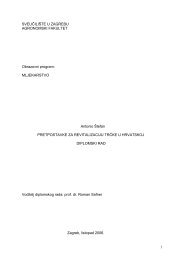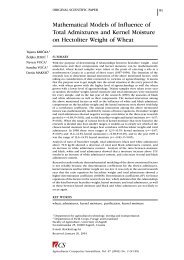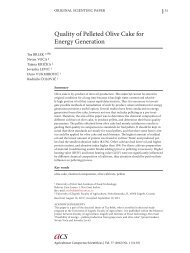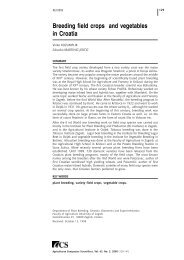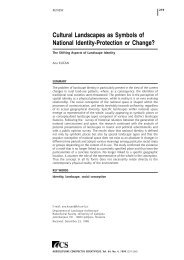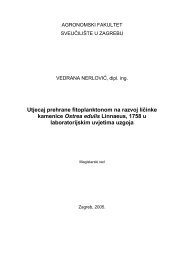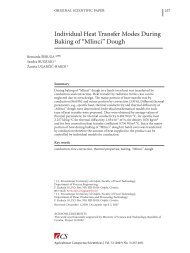Perception of Flower Beds in Public Green Areas
Perception of Flower Beds in Public Green Areas
Perception of Flower Beds in Public Green Areas
Create successful ePaper yourself
Turn your PDF publications into a flip-book with our unique Google optimized e-Paper software.
ORIGINAL SCIENTIFIC PAPER<br />
125<br />
<strong>Perception</strong> <strong>of</strong> <strong>Flower</strong> <strong>Beds</strong> <strong>in</strong> <strong>Public</strong><br />
<strong>Green</strong> <strong>Areas</strong><br />
Miroslav POJE 1( )<br />
Anton VUKELIĆ 2<br />
Ines HAN DOVEDAN 1<br />
Summary<br />
<strong>Flower</strong> beds are one <strong>of</strong> the aesthetically most strik<strong>in</strong>g elements <strong>of</strong> public green areas.<br />
Regardless <strong>of</strong> such an important role, there is very little research deal<strong>in</strong>g with flower<br />
beds as an <strong>in</strong>dividual element <strong>in</strong> space. Research is most <strong>of</strong>ten based on study<strong>in</strong>g<br />
flower species <strong>in</strong> a broader context.This research tried to ascerta<strong>in</strong> to what extent<br />
citizens and pr<strong>of</strong>essionals perceive flower beds <strong>in</strong> their everyday lives. Results show<br />
that more than half <strong>of</strong> the subjects notice flower beds on a daily basis. Furthermore,<br />
statistically significant differences were determ<strong>in</strong>ed <strong>in</strong> the pr<strong>of</strong>essionals’ and nonpr<strong>of</strong>essionals’<br />
knowledge <strong>of</strong> certa<strong>in</strong> locations <strong>in</strong> which flower beds are present, and<br />
<strong>in</strong> their tendency to participate <strong>in</strong> projects <strong>in</strong>volv<strong>in</strong>g the design and ma<strong>in</strong>tenance<br />
<strong>of</strong> flower beds. Namely, pr<strong>of</strong>essionals are more acqua<strong>in</strong>ted with the locations <strong>of</strong><br />
flower beds, and are more likely to participate <strong>in</strong> a project <strong>in</strong>volv<strong>in</strong>g the design and<br />
ma<strong>in</strong>tenance <strong>of</strong> flower beds. Results po<strong>in</strong>t to the importance <strong>of</strong> flower beds and the<br />
need for further research <strong>of</strong> their role as a part <strong>of</strong> urban green spaces.<br />
Key words<br />
perception, flower beds, urban green spaces<br />
1 University <strong>of</strong> Zagreb, Faculty <strong>of</strong> Agriculture, Department <strong>of</strong> Ornamental Plants, Landscape<br />
Architecture and Garden Art, Svetošimunska 25, HR-10000 Zagreb, Croatia<br />
e-mail: poje@agr.hr<br />
2 University <strong>of</strong> Zagreb, Faculty <strong>of</strong> Humanities and Social Sciences, Department <strong>of</strong> Sociology,<br />
Ivana Lučića 3, HR-10000 Zagreb, Croatia<br />
Received: March 13, 2013 | Accepted: May 22, 2013<br />
Agriculturae Conspectus Scientificus . Vol. 78 (2013) No. 2 (125-129)
126 Miroslav POJE, Anton VUKELIĆ, Ines HAN DOVEDAN<br />
Introduction<br />
<strong>Green</strong> spaces play a significant role <strong>in</strong> urban areas. Follow<strong>in</strong>g<br />
urban population growth (United Nations, 2011) the importance<br />
<strong>of</strong> green spaces is also <strong>in</strong>creas<strong>in</strong>g, especially because for a part<br />
<strong>of</strong> the urban population these areas are the only contact with<br />
the natural environment.<br />
Although there is a great number <strong>of</strong> studies on the importance<br />
<strong>of</strong> greenery <strong>in</strong> urban areas <strong>in</strong> general, they mostly focus<br />
on trees as the most important element <strong>of</strong> urban green spaces<br />
(Schroeder and Cannon, 1983; Dwyer et al., 1991; Sommer et<br />
al., 1992; Kaplan et al., 1998; Schroeder et al., 2006). In this context,<br />
very little research deals with flower beds that are, for the<br />
urban population, the most important element <strong>of</strong> urban green<br />
spaces after trees (Poje, 2012).<br />
Most <strong>of</strong> the exist<strong>in</strong>g research is based on study<strong>in</strong>g flower<br />
beds or the use <strong>of</strong> flower species <strong>in</strong> a broader context. A study<br />
<strong>of</strong> the preferences <strong>of</strong> spectators <strong>in</strong> a busy corridor <strong>in</strong> the South<br />
<strong>of</strong> Utah showed that flowers were the s<strong>in</strong>gle most important<br />
characteristic <strong>of</strong> the landscape for which subjects stopped to<br />
enjoy the view (Clay and Daniel, 2000). A study <strong>of</strong> various types<br />
<strong>of</strong> spatial arrangement <strong>of</strong> forests and forest edges lead to the<br />
conclusion that the placement <strong>of</strong> flowers beneath trees, <strong>in</strong> this<br />
case a monoculture <strong>of</strong> oxeye daisies (Leucanthemum vulgare<br />
Lam.), has no effect on the perception <strong>of</strong> safety and preference.<br />
Furthemore, that comb<strong>in</strong>ation <strong>of</strong> flowers beneath trees was the<br />
most preferred (Jorgensen et al., 2002). Accord<strong>in</strong>g to Todorova<br />
et al. (2002), the <strong>in</strong>terest <strong>in</strong> flowers amongst subjects is po<strong>in</strong>ted<br />
out by Iwamura and Yokohari (2001) where the local population<br />
participated more actively <strong>in</strong> the ma<strong>in</strong>tenance <strong>of</strong> parks with<br />
flower beds, and less <strong>in</strong> those without flower beds.<br />
Less research focuses on flower beds as <strong>in</strong>dividual elements.<br />
Thus Todorova et al. (2004) explored preferences for various<br />
street-plant<strong>in</strong>g models, particularly those with different compositions<br />
<strong>of</strong> flowers <strong>in</strong> comb<strong>in</strong>ations with or without trees. Results<br />
show that subjects preferred a comb<strong>in</strong>ation <strong>of</strong> trees and flowers<br />
over a comb<strong>in</strong>ation <strong>of</strong> trees and hedges, grass or pla<strong>in</strong> ground.<br />
The design <strong>of</strong> public areas should, to a certa<strong>in</strong> extent, be based<br />
on the needs and wishes <strong>of</strong> their users, although pr<strong>of</strong>essionals<br />
<strong>of</strong>ten use plants only tak<strong>in</strong>g <strong>in</strong>to consideration their own views<br />
and personal preferences (Kravanja, 2006). For that reason it is<br />
important to gather <strong>in</strong>formation from future users so that the<br />
area would be as functional as possible. Along the same l<strong>in</strong>e, it<br />
is important to determ<strong>in</strong>e the differences <strong>in</strong> the preferences <strong>of</strong><br />
pr<strong>of</strong>essionals and those <strong>of</strong> non-pr<strong>of</strong>essionals, and try to reach a<br />
compromise between their views on what the area should look<br />
like. Certa<strong>in</strong> research shows that expertise affects perception<br />
(Kaplan, 1973; Buyh<strong>of</strong>f et al., 1978; Brush et al., 2000; Herzog et<br />
al., 2000) and that pr<strong>of</strong>essionals are generally unaware <strong>of</strong> those<br />
differences among themselves and the general public (Kaplan<br />
and Kaplan, 1989; Strumse, 1996). Scott (2002) po<strong>in</strong>ts out that<br />
“ord<strong>in</strong>ary citizens” view the landscape as a whole, whilst pr<strong>of</strong>essionals<br />
differentiate between elements out <strong>of</strong> which it is comprised.<br />
These differences between the pr<strong>of</strong>essionals and the<br />
general public are also noticed <strong>in</strong> a study <strong>of</strong> visual preferences<br />
(Kaplan and Kaplan, 1989). Rogge et al. (2007) po<strong>in</strong>t out that<br />
farmers, experts and country-dwellers have a different perception<br />
<strong>of</strong> agrarian landscapes <strong>in</strong> Flanders. For these reasons, Kaplan<br />
and Kaplan (1983) warn about the negative effects <strong>of</strong> overlook<strong>in</strong>g<br />
these differences between the groups.<br />
The expenses <strong>of</strong> ma<strong>in</strong>ta<strong>in</strong><strong>in</strong>g flower beds can be reduced to<br />
a m<strong>in</strong>imum by <strong>in</strong>clud<strong>in</strong>g the end-users <strong>of</strong> the area. Todorova et<br />
al. (2002) po<strong>in</strong>t out the fact that users <strong>of</strong> public areas are ready<br />
to participate <strong>in</strong> plant<strong>in</strong>g and ma<strong>in</strong>ta<strong>in</strong><strong>in</strong>g <strong>of</strong> flower beds, but<br />
with the help <strong>of</strong> local authorities that would provide seedl<strong>in</strong>gs<br />
and a plant<strong>in</strong>g plan.<br />
The aim <strong>of</strong> this study was to <strong>in</strong>vestigate how urban dwellers<br />
perceive flower beds <strong>in</strong> their everyday life, to determ<strong>in</strong>e differences<br />
<strong>in</strong> perception between pr<strong>of</strong>essionals and non-pr<strong>of</strong>essionals<br />
and will<strong>in</strong>gness <strong>of</strong> pr<strong>of</strong>essionals and general population to participate<br />
<strong>in</strong> the process <strong>of</strong> design<strong>in</strong>g and ma<strong>in</strong>ta<strong>in</strong><strong>in</strong>g flower beds.<br />
Subjects and methods<br />
The study was conducted by method <strong>of</strong> survey (N=348). The<br />
sample covered part <strong>of</strong> the pr<strong>of</strong>essional (N=105) and part <strong>of</strong> the<br />
general public (N=243). The pr<strong>of</strong>essional public was represented<br />
by experts <strong>in</strong> the field <strong>of</strong> landscape architecture and ornamental<br />
plants, and students from the Faculty <strong>of</strong> Agriculture graduat<strong>in</strong>g<br />
<strong>in</strong> Landscape Architecture and Horticulture – Ornamental<br />
Plants. The general public is represented by part <strong>of</strong> the public<br />
whose pr<strong>of</strong>ession is neither <strong>of</strong> the above-stated pr<strong>of</strong>essions. The<br />
above sample was chosen because <strong>of</strong> differences <strong>in</strong> preferences<br />
between pr<strong>of</strong>essionals and the general public, which is expla<strong>in</strong>ed<br />
<strong>in</strong> the previous section.<br />
The survey was conducted <strong>in</strong> April 2012 comb<strong>in</strong><strong>in</strong>g the personally<br />
adm<strong>in</strong>istered (N=105) and electronic survey method.<br />
Personally adm<strong>in</strong>istered questionnaires were filled by a part <strong>of</strong><br />
expert students at Faculty <strong>of</strong> Agriculture and part <strong>of</strong> general<br />
public at Faculty <strong>of</strong> Humanities and Social Sciences. Electronic<br />
survey method was conducted via questionnaire which was<br />
filled out <strong>in</strong> a website specially created for this purpose (N=243).<br />
Advantages and disadvantages <strong>of</strong> electronic survey method were<br />
summarized by Roth (2006).<br />
The questionnaire was comprised <strong>of</strong> a series <strong>of</strong> questions<br />
concern<strong>in</strong>g the perception <strong>of</strong> flower beds and knowledge about<br />
flower beds, along with a series <strong>of</strong> questions aimed at measur<strong>in</strong>g<br />
the socio-demographic characteristics <strong>of</strong> the subjects. The<br />
series <strong>of</strong> questions about notic<strong>in</strong>g flower beds and knowledge<br />
<strong>of</strong> them <strong>in</strong>cluded the follow<strong>in</strong>g <strong>in</strong>dicators: frequency <strong>of</strong> notic<strong>in</strong>g<br />
flower beds <strong>in</strong> daily movements, the ability <strong>of</strong> l<strong>in</strong>k<strong>in</strong>g flower<br />
beds to particular locations <strong>in</strong> the city <strong>of</strong> Zagreb, estimation <strong>of</strong><br />
the sufficiency <strong>of</strong> flower beds <strong>in</strong> public green spaces <strong>in</strong> the city <strong>of</strong><br />
Zagreb, the degree <strong>of</strong> knowledge <strong>of</strong> the existence <strong>of</strong> flower beds<br />
<strong>in</strong> certa<strong>in</strong> locations <strong>in</strong> the city <strong>of</strong> Zagreb and will<strong>in</strong>gness to participate<br />
<strong>in</strong> projects <strong>of</strong> design<strong>in</strong>g and ma<strong>in</strong>ta<strong>in</strong><strong>in</strong>g flower beds.<br />
The data were analyzed us<strong>in</strong>g descriptive statistics and the<br />
chi-square test. Chi-square test was used for the comparison <strong>of</strong><br />
frequencies. As statistically significant was considered p
<strong>Perception</strong> <strong>of</strong> <strong>Flower</strong> <strong>Beds</strong> <strong>in</strong> <strong>Public</strong> <strong>Green</strong> <strong>Areas</strong><br />
127<br />
Results and discussion<br />
The purpose <strong>of</strong> the first <strong>in</strong>dicator was to determ<strong>in</strong>e the frequency<br />
<strong>of</strong> notic<strong>in</strong>g flower beds. Figure 1 shows basic descriptive<br />
statistics display<strong>in</strong>g answers to the question “How <strong>of</strong>ten do you<br />
notice flower beds <strong>in</strong> your daily movements“. The majority <strong>of</strong><br />
respondents (53%) notice flower beds <strong>of</strong>ten or daily <strong>in</strong> their everyday<br />
movements. On the other hand, 25% <strong>of</strong> respondents rarely<br />
or never notice flower beds <strong>in</strong> their daily movement.<br />
A high percentage <strong>of</strong> subjects (67.5%) are able to l<strong>in</strong>k a flower<br />
bed to its particular location <strong>in</strong> Zagreb, be it a district, street or<br />
city square. Answers to the question “Can you l<strong>in</strong>k a flower bed<br />
to a particular location (district, street, city square) <strong>in</strong> Zagreb”<br />
are presented <strong>in</strong> Figure 2.<br />
The questionnaire provided an open-ended question; subjects<br />
who were able to l<strong>in</strong>k flower beds to locations also filled blank<br />
space with the name <strong>of</strong> the district, street or city square that<br />
they recognized as the spot conta<strong>in</strong><strong>in</strong>g the flower bed. The aim<br />
<strong>of</strong> this question was to check which locations with flower beds<br />
are parts <strong>of</strong> respondent’s memory. For that reason, they were not<br />
<strong>of</strong>fered any locations as <strong>in</strong> another part <strong>of</strong> research which will<br />
be shown later <strong>in</strong> text. They mostly mentioned the locations <strong>in</strong><br />
the center <strong>of</strong> the city such as the Marshall Tito Square, the space<br />
<strong>in</strong> front <strong>of</strong> Mimara Museum, the Nikola Šubić Zr<strong>in</strong>ski Square,<br />
the Strossmayer Square and those outside the city center such as<br />
Maksimir Park (the area <strong>in</strong> front <strong>of</strong> the ma<strong>in</strong> entrance), Bundek<br />
and other locations.<br />
A statistically significant difference is determ<strong>in</strong>ed <strong>in</strong> the ability<br />
to l<strong>in</strong>k a flower bed to a particular location between the two<br />
types <strong>of</strong> public. Pr<strong>of</strong>essionals were able to l<strong>in</strong>k a flower bed to<br />
its location to a greater extent than the general public (χ 2 =9.099;<br />
df=1; p
128 Miroslav POJE, Anton VUKELIĆ, Ines HAN DOVEDAN<br />
I don't know<br />
No, I'm not <strong>in</strong>terested<br />
16<br />
81<br />
the area least identified as a location <strong>in</strong> which there are no flower<br />
beds was SRC Jarun (35.3%). Answers to the question “Are there<br />
any flower beds <strong>in</strong> the follow<strong>in</strong>g locations <strong>in</strong> Zagreb” are presented<br />
<strong>in</strong> Table 1.<br />
Maybe, I'm not sure<br />
159<br />
Yes, def<strong>in</strong>itely<br />
92<br />
0 30 60 90 120 150 180<br />
Figure 4.<br />
Will<strong>in</strong>gness to participate <strong>in</strong> projects <strong>of</strong> design<strong>in</strong>g and<br />
ma<strong>in</strong>ta<strong>in</strong><strong>in</strong>g flower beds<br />
Roughly half <strong>of</strong> the subjects was unsure whether or not<br />
they would participate (Maybe, I’m not sure), which could have<br />
a positive connotation consider<strong>in</strong>g one <strong>of</strong> the options was also<br />
I don’t know. It is assumed that such a group <strong>of</strong> subjects would<br />
express a will<strong>in</strong>gness to participate, if it were expla<strong>in</strong>ed to them<br />
<strong>in</strong> detail what such a project would <strong>in</strong>clude and what could be<br />
expected <strong>of</strong> them. Exist<strong>in</strong>g research shows citizens’ consent to<br />
participate <strong>in</strong> such projects. Todorova et al. (2002) determ<strong>in</strong>ed<br />
that 34% <strong>of</strong> users were will<strong>in</strong>g to participate <strong>in</strong> plant<strong>in</strong>g, while<br />
28% were <strong>in</strong>cl<strong>in</strong>ed to engage <strong>in</strong> the ma<strong>in</strong>tenance <strong>of</strong> flower beds,<br />
but were dis<strong>in</strong>cl<strong>in</strong>ed to participate <strong>in</strong> the process <strong>of</strong> plann<strong>in</strong>g<br />
such a project. The same authors stated that 40% <strong>of</strong> the subjects<br />
were unwill<strong>in</strong>g to participate <strong>in</strong> such a project. However, this research<br />
shows a lesser percentage <strong>of</strong> so <strong>in</strong>cl<strong>in</strong>ed subjects (23.3%).<br />
A statistically significant difference is determ<strong>in</strong>ed between<br />
the general and pr<strong>of</strong>essional public concern<strong>in</strong>g the will<strong>in</strong>gness<br />
<strong>of</strong> participat<strong>in</strong>g <strong>in</strong> such a project (χ 2 =23.374; df=2; p
<strong>Perception</strong> <strong>of</strong> <strong>Flower</strong> <strong>Beds</strong> <strong>in</strong> <strong>Public</strong> <strong>Green</strong> <strong>Areas</strong><br />
129<br />
References<br />
Brush R., Chenoweth R.E., Barman T. (2000). Group differences <strong>in</strong><br />
the enjoyability <strong>of</strong> driv<strong>in</strong>g through rural landscapes. Landscape<br />
and Urban Plann<strong>in</strong>g 47: 39-45<br />
Buyh<strong>of</strong>f G.J.,Wellman J.D., Harvey H., Fraser R.A. (1978).<br />
Landscape architects’ <strong>in</strong>terpretation <strong>of</strong> people’s landscape preferences.<br />
J. Environ. Manage. 6: 255-262<br />
Clay G.R., Daniel T.C. (2000). Scenic landscape assessment: the<br />
effects <strong>of</strong> land management jurisdiction on public perception <strong>of</strong><br />
scenic beauty. Landscape and Urban Plann<strong>in</strong>g 49: 1-13<br />
Dweyer J.F., Schroeder H.W., Gobster P.H. (1991). The significance<br />
<strong>of</strong> urban trees and forests: toward a deeper understand<strong>in</strong>g <strong>of</strong><br />
values. Journal <strong>of</strong> Arboriculture 17: 276-284<br />
Herzorg T.R., Herbert E.J., Kaplan R., Crooks C.L. (2000). Cultural<br />
and developmental comparison <strong>of</strong> landscape perceptions and<br />
preferences. Environ. Behav. 32 (3): 323-346<br />
Iwamura T., Yokohari M. (2001). Review and future perspectives<br />
<strong>of</strong> park ma<strong>in</strong>tenance and management by local communities<br />
<strong>in</strong> Kobe City, Hyogo prefecture. J. Jpn. Inst. Landscape<br />
Architecture 64 (5): 671-674 (<strong>in</strong> Japanese with English<br />
summary)<br />
Jorgensen A., Hitchmough J., Calvert T. (2002). Woodland spaces<br />
and edges: their impact on perception <strong>of</strong> safety and preference.<br />
Landscape and Urban Plann<strong>in</strong>g 60: 135- 150<br />
Kaplan R. (1973). Predictors <strong>of</strong> environmental preference: designers<br />
and ‘clients’. In: Preiser,W.F.E (Ed.), Environmental Design<br />
Research. Dowden, Hutch<strong>in</strong>son & Ross, Stroudsburgh, PA<br />
Kaplan R., Kaplan S., Ryan R.L. (1998). With Pople <strong>in</strong> M<strong>in</strong>d. Design<br />
and Management <strong>of</strong> Everyday Nature. Wash<strong>in</strong>gton DC. Island<br />
Press<br />
Kaplan R., Kaplan S. (1983). Cognition and Environment.<br />
Function<strong>in</strong>g <strong>in</strong> an Uncerta<strong>in</strong> World. Ulrichs Bookstore, Ann<br />
Arbor, MI<br />
Kaplan R., Kaplan S. (1989). The Experience <strong>of</strong> Nature: A<br />
Psychological Perspective. Cambridge University Press, New<br />
York (Republished by Ulrich’s, Ann Arbor, MI: 1996)<br />
Kravanja N. (2006). Significant perceptual properties <strong>of</strong> outdoor<br />
ornamental plants. Acta agriculturae Slovenica 87: 333-342<br />
Poje M. (2012). Typology and Social <strong>Perception</strong> <strong>of</strong> the Attributes <strong>of</strong><br />
<strong>Flower</strong> <strong>Beds</strong> <strong>in</strong> <strong>Public</strong> <strong>Areas</strong>. PhD Thesis. University <strong>of</strong> Zagreb<br />
Faculty <strong>of</strong> Agriculture<br />
Rogge E., Nevens F., Gul<strong>in</strong>ck H. (2007). <strong>Perception</strong> <strong>of</strong> rural landscapes<br />
<strong>in</strong> Flanders: Look<strong>in</strong>g beyond aesthetics. Landscape and<br />
Urban Plann<strong>in</strong>g 82: 159-174<br />
Roth M. (2006). Validat<strong>in</strong>g the use <strong>of</strong> Internet survey techniques<br />
<strong>in</strong> visual landscape assessment – An empirical study from<br />
Germany. Landscape and Urban Plann<strong>in</strong>g 78: 179-192<br />
Schroeder H., Flannigan J., Coles R. (2006). Residents’ Attitudes<br />
Toward Street Trees <strong>in</strong> the UK and U.S. Communities.<br />
Arboriculture & Urban Forestry 32: 236-246<br />
Schroeder H.W., Cannon Jr.W.N. (1983). The esthetic contribution<br />
<strong>of</strong> trees to residential streets <strong>in</strong> Ohio towns. J. Arboric. 9 (9):<br />
237-243<br />
Scott A. (2002). Assess<strong>in</strong>g public perception <strong>of</strong> landscape: the<br />
LANDMAP experience. Landscape Research 27: 271-295<br />
Sommer R., Guenther H., Cecchett<strong>in</strong>i C.L. (1992). A user-based<br />
method for rat<strong>in</strong>g street trees. Landscape Research 17: 100-107<br />
Strumse E. (1996). Demographic differences <strong>in</strong> the visual preferences<br />
for agrarian landscapes <strong>in</strong> western Norway. J. Environ.<br />
Psych. 16: 17-31<br />
Todorova A., Asakawa S., Aikoh T. (2002). Attitudes towards street<br />
flowers <strong>in</strong> Sapporo. J. Jpn. Inst. Landscape Architecture 65 (5):<br />
717-722<br />
Todorova A., Asakawa S., Aikoh T. (2004). Preferences for and<br />
attitudes towards street flowers and trees <strong>in</strong> Sapporo, Japan.<br />
Landscape and Urban Plann<strong>in</strong>g 69: 403-416<br />
U.N. Department <strong>of</strong> Economics and Social Affairs. Population<br />
Division (2011). Population Distribution, Urbanization, Internal<br />
Migration and Development: An International Perspective<br />
(ESA/P/WP/223). United Nations publication<br />
acs78_17<br />
Agric. conspec. sci. Vol. 78 (2013) No. 2





